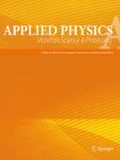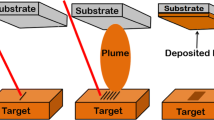Abstract.
One of the most significant features of pulsed-laser deposition (PLD) in vacuum as compared to conventional deposition methods is that a significant number of ions are deposited with a high kinetic energy of about 100 eV. Using Fe/Ag multilayers, we show that the deposition of energetic particles during PLD leads to implantation into the existing film. The film growth can be described by a growth mode in which the material does not grow on top, but rather within the topmost few monolayers of the already deposited film. To examine this “subsurface growth”, in situ resistance measurements and electron diffraction experiments were performed. Resistance measurements show a drop in conductance after beginning a new Fe layer, an effect attributed to implantation and alloying at the interface. Electron diffraction experiments allow the observation of the structural change from fcc-Ag to bcc-Fe and vice versa. These experiments are interpreted by the use of a Bain transformation to describe a homogeneous transformation between the two structures.
Similar content being viewed by others
Author information
Authors and Affiliations
Additional information
Received: 21 July 1999 / Accepted: 1 September 1999 / Published online: 22 December 1999
Rights and permissions
About this article
Cite this article
Fähler, S., Weisheit, M., Kahl, S. et al. The interface of laser-deposited Fe/Ag multilayers: evidence for the “subsurface growth mode” during pulsed-laser deposition and examination of the bcc–fcc transformation . Appl Phys A 69 (Suppl 1), S459–S462 (1999). https://doi.org/10.1007/s003390051438
Issue Date:
DOI: https://doi.org/10.1007/s003390051438




